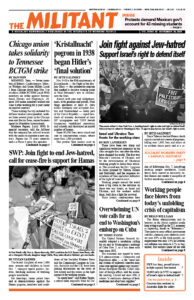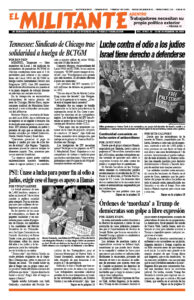Nov. 9-10 is the 85th anniversary of Kristallnacht — the Night of the Broken Glass — the nationwide pogrom that marked a decisive turning point in Nazi Germany’s war to exterminate the Jews.
Armed with axes and sledgehammers, with gasoline and pistols, Nazi thugs murdered at least 91 Jews across Germany and occupied Austria and Sudetenland — today part of the Czech Republic — raped hundreds of women; destroyed at least 267 synagogues and 7,000 Jewish businesses; vandalized cemeteries and schools; and destroyed an untold number of homes.
Some 30,000 Jews were seized and sent to concentration camps, where more than 1,000 perished.
The pretext Nazi leaders used to unleash this preplanned brutality was the death of German diplomat Ernst vom Rath. He was shot on Nov. 7, 1938, in Paris by Herschel Grynszpan, a 17-year-old Polish Jew, and died two days later.
Grynszpan had discovered his family had been arrested, humiliated and mistreated, and sent by cattle car without food or water to the Polish border.
On his arrest the teenager said, “Being a Jew is not a crime. I am not a dog. I have a right to live and the Jewish people have a right to exist on earth.”
Adolf Hitler and his Nazi party had come to power in 1933, after the Stalinized Communist Party of Germany betrayed the millions of working people who backed it by refusing to stand up to the Nazi thugs. Instead, the CP insisted, “After Hitler, then us.”
Kirstallnacht marked the beginning of what the Nazis called the “final solution” to the Jewish question — the extermination of all Jews. Jews were sent to concentration camps simply because they were Jews. By the time the Nazis were toppled on May 8, 1945, more than 6 million Jews had been slaughtered.
Joseph Goebbels, Hitler’s chief of propaganda, claimed that Kristallnacht was a spontaneous outburst by the German people. That was a lie. Gestapo Chief Heinrich Muller had sent an order to all police offices Nov. 9 saying that “actions against Jews, especially against their synagogues, will take place throughout the Reich shortly. They are not to be interfered with.”
Glass shattered by Nazi SS and SA thug attacks on synagogues and other buildings and scattered throughout the streets of the country gave the massacre its name. The Hitler regime blamed the Jews for the damage and collectively fined them 6 million marks.
The Nazis banned all Jewish children from public schools. The driver’s licenses of Jews were suspended. The Hitler regime imposed an evening curfew on Jews. Jews were prohibited from having firearms or knives.
The Socialist Workers Party responded to Kristallnacht with a statement on the front page of Socialist Appeal, “Let the Refugees into U.S.! Open the Doors to Victims of Hitler’s Nazi Terror!” “The Brown-shirted monsters do not even bother to conceal their aim: the physical extermination of every Jew in Great-Germany,” the SWP said.
“The workers of the United States must take the initiative in a mighty and effective protest against the Hitlerite pogroms.”
“Solidarity with those who suffer at the hands of fascism is one of the best ways of establishing, in this country, an unbreakable wall against the advance of American Fascism,” the SWP explained.
The party campaigned with the paper, using it to help organize united front demonstrations and educate workers on what was at stake.
Under pressure to open the U.S. border, President Franklin D. Roosevelt denounced the Nazi pogrom, saying, “I myself could scarcely believe that such things could occur in a 20th-century civilization.”
But those were just crocodile tears. Washington kept its border shut to the Jews, then, throughout the imperialist war, and after.
Fascism is not around the corner in the U.S. today. But a mighty outcry against the pogrom carried out by Hamas Oct. 7 and a strong show of support for Israel’s right to exist is decisive in preparing for inevitable battles in the future.

